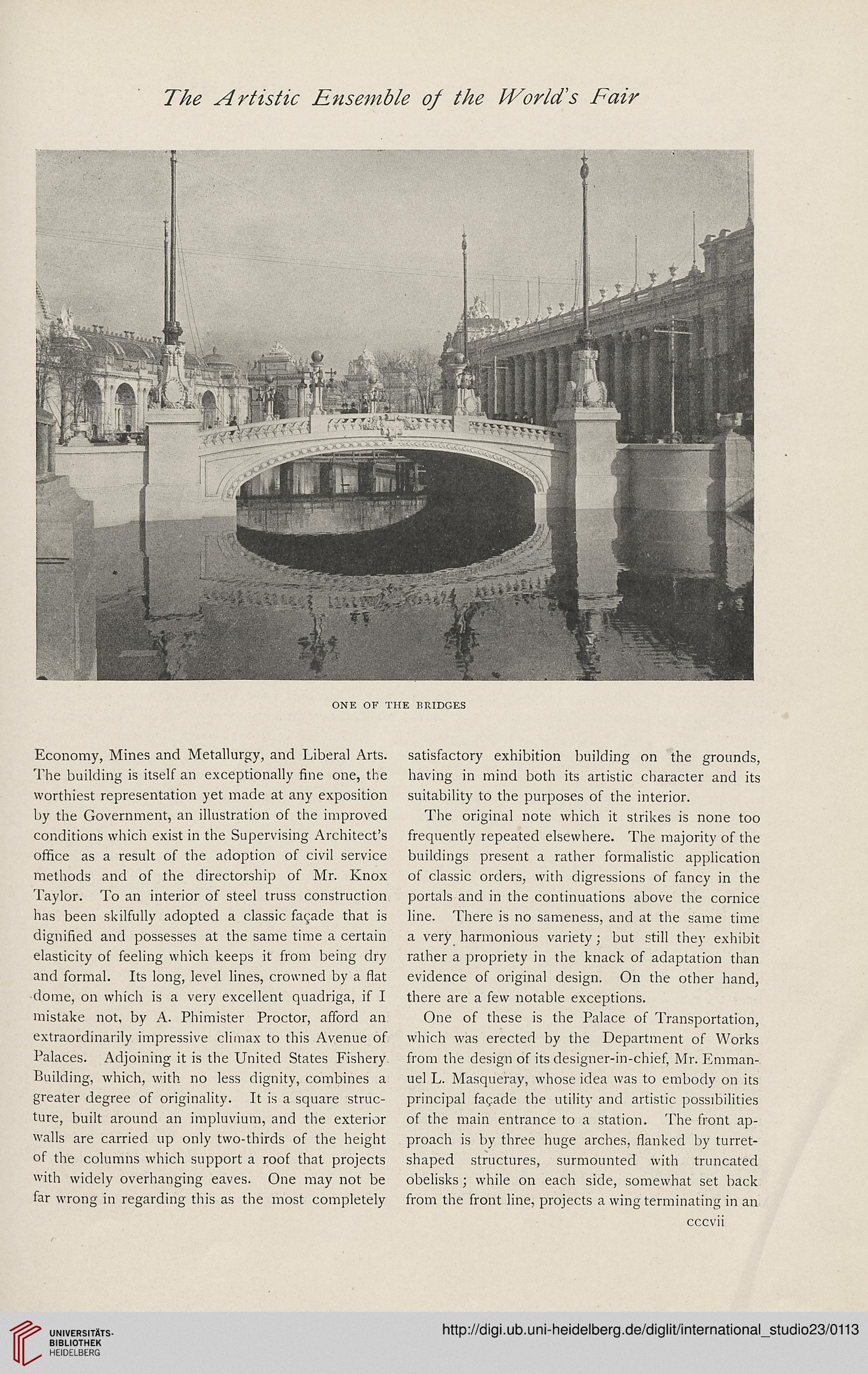The Artistic Ensemble of the World's Fair
ONE OF THE BRIDGES
Economy, Mines and Metallurgy, and Liberal Arts.
The building is itself an exceptionally fine one, the
worthiest representation yet made at any exposition
by the Government, an illustration of the improved
conditions which exist in the Supervising Architect’s
office as a result of the adoption of civil service
methods and of the directorship of Mr. Knox
Taylor. To an interior of steel truss construction
has been skilfully adopted a classic fagade that is
dignified and possesses at the same time a certain
elasticity of feeling which keeps it from being dry
and formal. Its long, level lines, crowned by a flat
dome, on which is a very excellent quadriga, if I
mistake not, by A. Phimister Proctor, afford an
extraordinarily impressive climax to this Avenue of
Palaces. Adjoining it is the United States Fishery
Building, which, with no less dignity, combines a
greater degree of originality. It is a square struc-
ture, built around an impluvium, and the exterior
walls are carried up only two-thirds of the height
of the columns which support a roof that projects
with widely overhanging eaves. One may not be
far wrong in regarding this as the most completely
satisfactory exhibition building on the grounds,
having in mind both its artistic character and its
suitability to the purposes of the interior.
The original note which it strikes is none too
frequently repeated elsewhere. The majority of the
buildings present a rather formalistic application
of classic orders, with digressions of fancy in the
portals and in the continuations above the cornice
line. There is no sameness, and at the same time
a very harmonious variety; but still they exhibit
rather a propriety in the knack of adaptation than
evidence of original design. On the other hand,
there are a few notable exceptions.
One of these is the Palace of Transportation,
which was erected by the Department of Works
from the design of its designer-in-chief, Mr. Emman-
uel L. Masqueray, whose idea was to embody on its
principal fagade the utility and artistic possibilities
of the main entrance to a station. The front ap-
proach is by three huge arches, flanked by turret-
shaped structures, surmounted with truncated
obelisks; while on each side, somewhat set back
from the front line, projects a wing terminating in an
cccvii
ONE OF THE BRIDGES
Economy, Mines and Metallurgy, and Liberal Arts.
The building is itself an exceptionally fine one, the
worthiest representation yet made at any exposition
by the Government, an illustration of the improved
conditions which exist in the Supervising Architect’s
office as a result of the adoption of civil service
methods and of the directorship of Mr. Knox
Taylor. To an interior of steel truss construction
has been skilfully adopted a classic fagade that is
dignified and possesses at the same time a certain
elasticity of feeling which keeps it from being dry
and formal. Its long, level lines, crowned by a flat
dome, on which is a very excellent quadriga, if I
mistake not, by A. Phimister Proctor, afford an
extraordinarily impressive climax to this Avenue of
Palaces. Adjoining it is the United States Fishery
Building, which, with no less dignity, combines a
greater degree of originality. It is a square struc-
ture, built around an impluvium, and the exterior
walls are carried up only two-thirds of the height
of the columns which support a roof that projects
with widely overhanging eaves. One may not be
far wrong in regarding this as the most completely
satisfactory exhibition building on the grounds,
having in mind both its artistic character and its
suitability to the purposes of the interior.
The original note which it strikes is none too
frequently repeated elsewhere. The majority of the
buildings present a rather formalistic application
of classic orders, with digressions of fancy in the
portals and in the continuations above the cornice
line. There is no sameness, and at the same time
a very harmonious variety; but still they exhibit
rather a propriety in the knack of adaptation than
evidence of original design. On the other hand,
there are a few notable exceptions.
One of these is the Palace of Transportation,
which was erected by the Department of Works
from the design of its designer-in-chief, Mr. Emman-
uel L. Masqueray, whose idea was to embody on its
principal fagade the utility and artistic possibilities
of the main entrance to a station. The front ap-
proach is by three huge arches, flanked by turret-
shaped structures, surmounted with truncated
obelisks; while on each side, somewhat set back
from the front line, projects a wing terminating in an
cccvii




